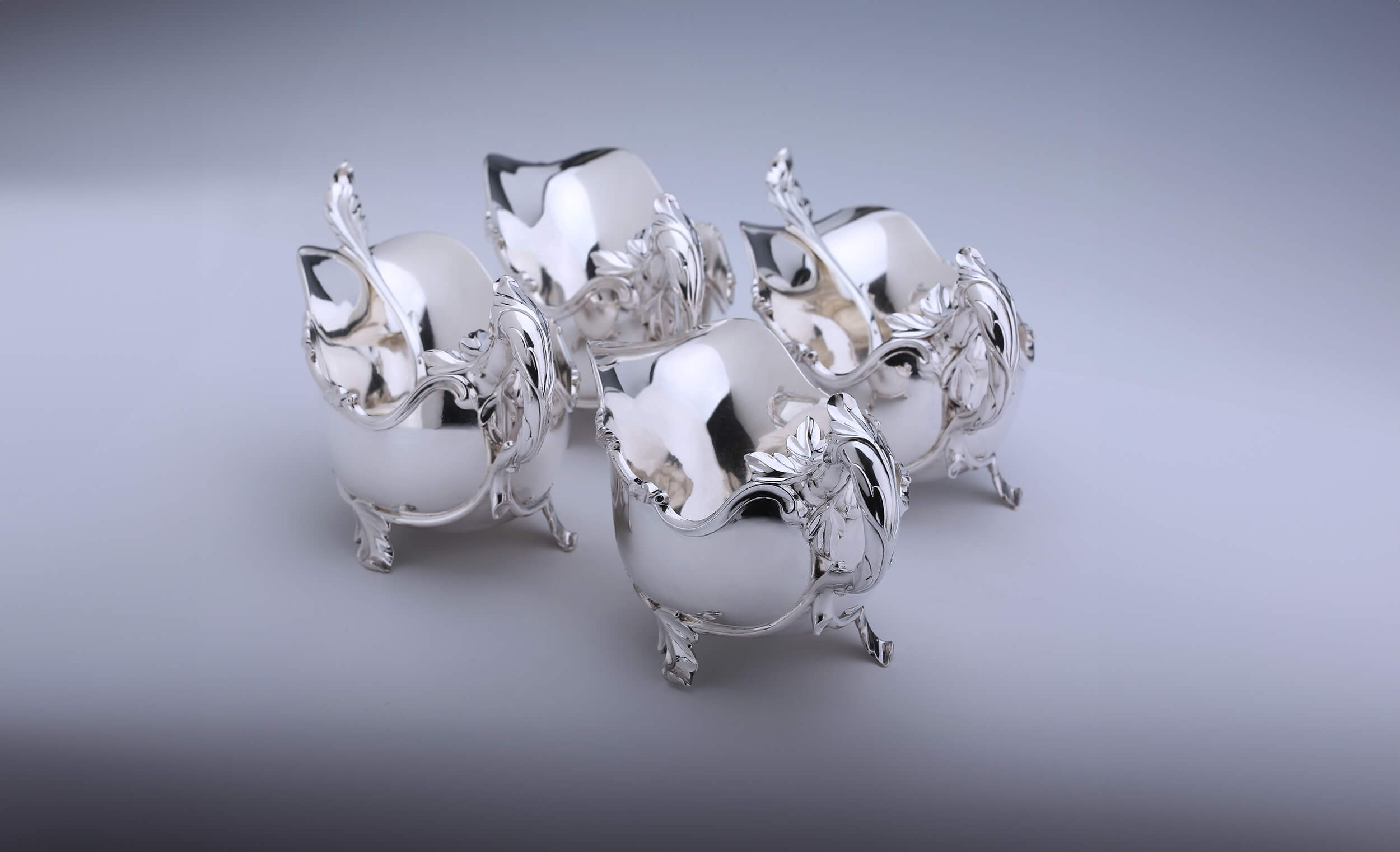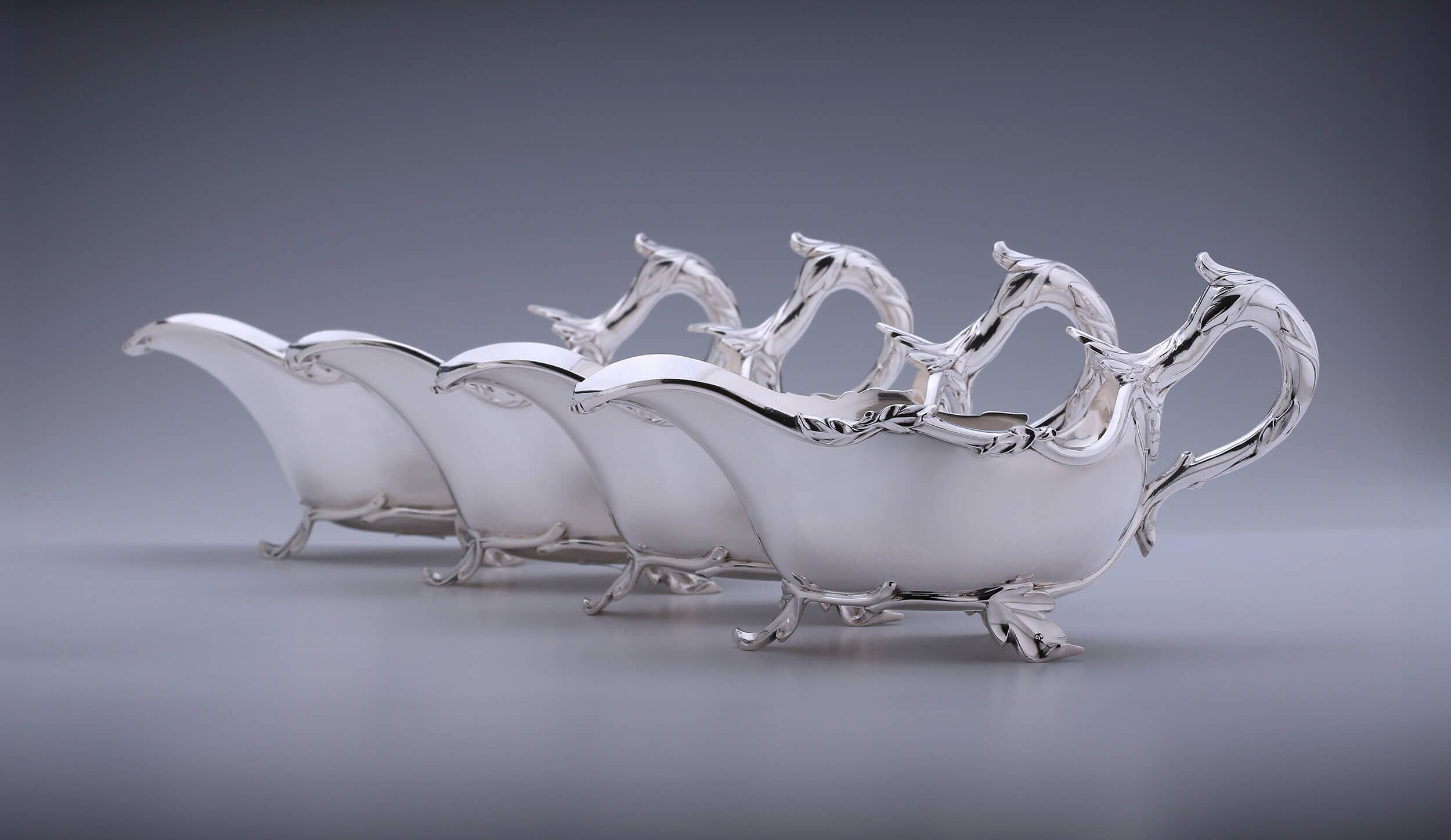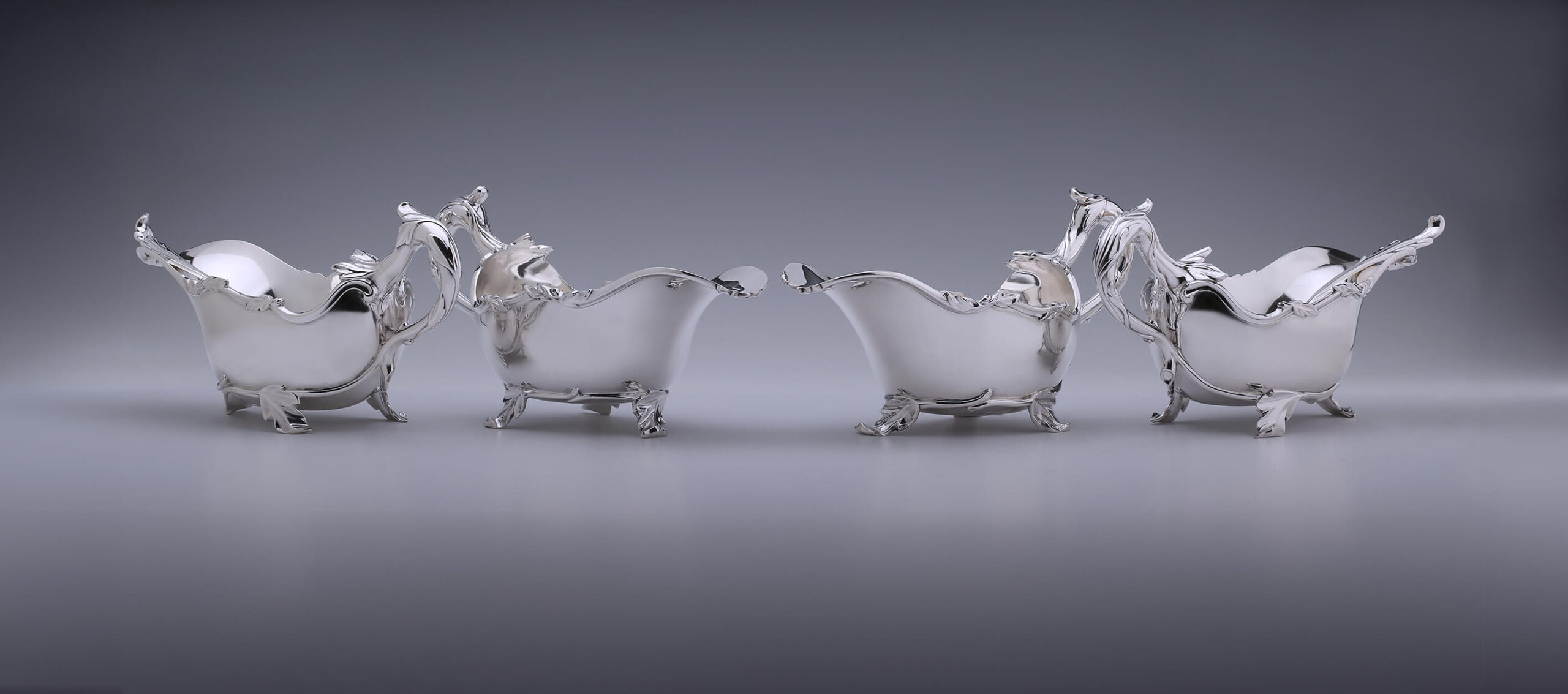This exceptional and elegant set of four sauce boats with ladles was superbly designed and made by Pieter Kersbergen. Sauce boats of this heavy quality are very rare in eighteenth-century Dutch silver. Together they weigh almost two kilos, and that is without the ladles. It is very seldom that the original sauce ladles have survived with the boats. Thinner sauces could be poured out, but a ladle was needed for thicker condiments such as mayonnaise.
Four Sauce Boats with Ladles
The round bowls of the ladles have scalloped edges and elegant, curved handles in the shape of a leaf on a stem. The design aligns seamlessly with the sauce boats, which have completely plain sides with a raised and protruding lip at the front. Along the curved upper rim is a cast moulded frame with scrolls and leaves. They all have a gnarled, branch-shaped handle with leaves that terminate in two twigs that follow the underside of the boat. The three gently curved leaves on these twigs serve as feet.
Incomparable Elegance
The smooth, gently curved shape of these sauce boats allows the reflecting effect of the silver to show to best advantage and is typical of the Hague Louis XV style. Silversmiths in the royal residence had an unparalleled feeling for proportion and were able to produce pieces of silver with an incomparable elegance. This Hague design of Rococo silver is a direct reflection of the city’s social and political function. The residence of the stadholder’s court, the seat of the States General and the establishments of the many ambassadors who lived there, the city was constantly visited by foreign diplomats. The result was an aristocratic lifestyle and taste and although The Hague was a relatively small city, many wealthy citizens lived there. They, too, wanted to impress guests with the lavishness of their hospitality and this called for a certain status. In consequence, Hague silversmiths were never short of commissions.
Hague Style
The most important Hague silversmiths in the third quarter of the eighteenth century display a remarkable unity in the design and ornamentation of the pieces they made. Engelbart Joosten, Jan Willem Burger, Pieter Kersbergen, Isaac Samuel Busard and Reynier de Haan used the lifelike branch and leaf decorations in very similar ways on the often smooth, understated and distinguished pieces. A great advantage of this was that services could easily be put together from the work of these different Hague silversmiths. To judge by the objects they made, it is safe to assume that they worked very closely together.
This Hague style was followed by silversmiths in other towns and cities. Many noble families who had a house in The Hague or held important government posts there also often had a château or country estate in the province. They preferred to buy their silver in the court city but were often supplied with additional pieces by provincial makers. This Hague influence is evident in silver from Arnhem, Nijmegen, Zutphen, Middelburg, Maastricht and beyond.
Madame de Pompadour
These natural forms in Rococo silver were influenced to a significant extent by Madame de Pompadour. In 1745 she became the mistress of the French king Louis XV. A group of courtiers and financiers brought her to the notice of the king so that they would be able to gain his ear. Their ruse was a success. She was to become one of Louis XV’s most celebrated mistresses and had a great influence on the king. She had a profound interest in the arts. Louis XV appointed her the patroness of artists and writers. She was a great supporter of the Romantic ideas of the philosopher Jean Jacques Rousseau and his ‘back to nature’ aesthetic. Her love of nature had a considerable effect on the artists and artisans of the time, who took their inspiration from it. These sauce boats are a telling example of the influence of the French court on Dutch decorative arts.
Coulis
Sauce boats originated in France. The oldest known examples date from around 1690 and were made for the French court. In 1651 François Pierre de la Varenne, the marquis d’Uxelles’s cook, published Le Cuisinier François in which he describes for the first time the use of roux for thickening sauces. Coulis, a concentrated bouillon with herbs and breadcrumbs, was the forerunner of eighteenth-century stock, forming the basis of countless sauces such as Béchamel and Mayonnaise, which were created in the seventeenth and eighteenth centuries. And of course they had to be served appropriately.
Frivolous
In the seventeenth century, a dinner service in the Republic primarily consisted of a range of dishes, jugs, bowls and plates. In the eighteenth century, tureens and sauce boats were added. No longer set out on sideboards, these objects made their way on to the table. The earliest known Dutch pair of sauce boats was made in The Hague in 1714. That model, with two lips, one opposite the other and two handles between them on the long sides, followed the French fashion in the strictly symmetrical Louis XIV style. As a response to this rigid style, around the middle of the eighteenth century, sauce boats in the then prevailing Louis XV style began to appear. This model by Pieter Kersbergen, with leaves and twigs, is among the most frivolous models made in The Hague and is in Louis XV style.
Pieter Kersbergen
The maker’s mark PK on these sauce boats and ladles has been attributed to Pieter Kersbergen. He was registered in the oath book in the Hague gold- and silversmiths’ guild on 4 June 1749. Three years earlier he had married Elisabeth van der Vet. The couple lived in Casuaristraat. Kersbergen was a productive silversmith. We know of pieces by him including candlesticks, casters, cutlery and trays, some of which are now in the collections of the Rijksmuseum, the Centraal Museum Utrecht and the Hague Kunstmuseum.
Kersbergen died on 12 April 1772 at the age of fifty-one. There are several pieces bearing his maker’s mark with date letters after 1772. Most probably his widow continued to run his workshop at least until 1779 as there are several pieces known bearing kerbergen’s maker’s mark with date letters after 1772. This was not unusual at that time and was allowed by the guild.
Marks
Marked on the underside of the sauce boats and the ladle bowls with the Hague city assay mark, the maker’s mark PK for Pieter Kersbergen, the Dutch Lion and the date letter D for 1775, two boats with the date letter H for 1779. Also with the re-assay mark a crowned O.
Provenance
Dutch noble family, by descent to the last owner
Literature:
For a nearly identical pair of sauce boats and a spoon by the same maker see exh. cat. Haags Silver uit Vijf Eeuwen, Haags Gemeente Museum, 1967 cat no. 260 and no. 289.
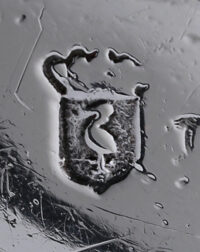
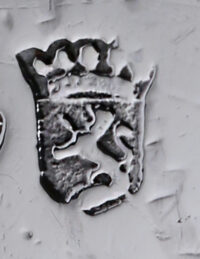
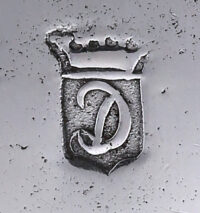
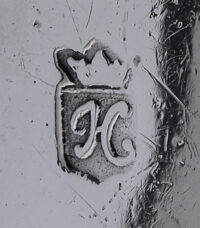
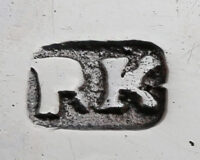
This site is protected by reCAPTCHA and the Google Privacy Policy and Terms of Service apply.
